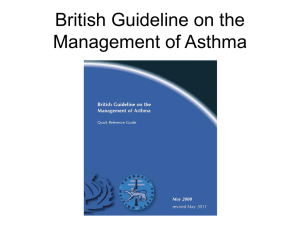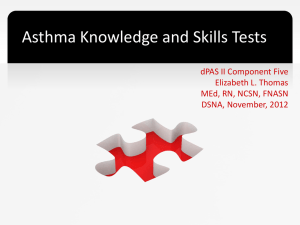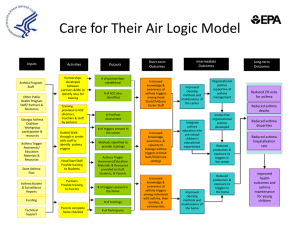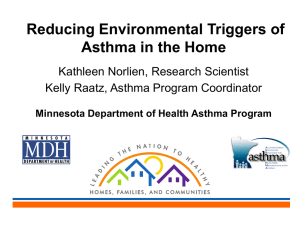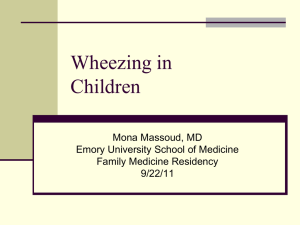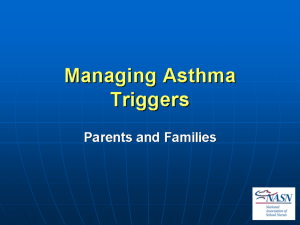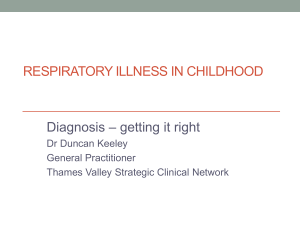Clinical Manifestations of Asthma
advertisement
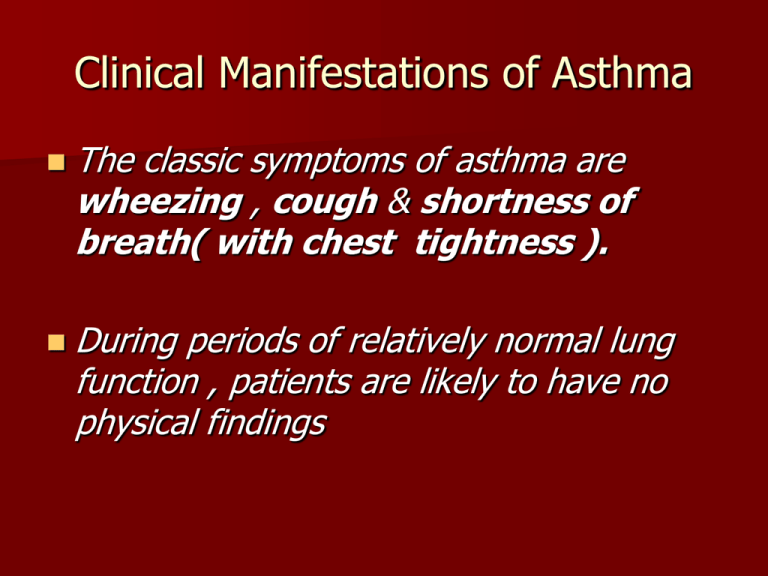
Clinical Manifestations of Asthma The classic symptoms of asthma are wheezing , cough & shortness of breath( with chest tightness ). During periods of relatively normal lung function , patients are likely to have no physical findings Wheezing: Wheezing is the most common finding during acute airway obstruction, & the chest may be hyperresonant on percussion. Cough: The cough can be nonproductive or raise copious amounts of sputum ( particularly in the presence of infection ) Eosinophils & their debris may cause a yellow discoloration of sputum , even when infection is absent Occationally , cough is the only manifestation of asthma. Shortness of breath: Dyspnea tends to vary greatly over time , depending on the severity of airflow obstruction. Chest tightness : commonly occurs with dyspnea & may be confused with angina pectoris . Most patients associate their chest tightness with the sensation of being unable to take in a full & satisfying breath . Physical signs of asthma : (in the chest) During an attack the chest in held near position of full inspiration & percussion note may be hyperresonant. Breath sound are vesicular with prolong expiratory phase. Bilateral expiratory & may be inspiratory ronchi. In very sever asthma the chest may be silent, because of insufficient air flow. No physical signs between attack except in patients with chronic asthma which there is usually expiratory rhonchi Sever asthma starting from childhood may cause pigeon chest deformity (pectus carinatum) According to the clinical features we can divide asthma into the following: 1- Episodic asthma (usually atopic). 2- Chronic asthma (non atopic). 3- Acute sever asthma (status asthmatics). • • History of allergy is very important. An extremely common feature of asthma is nocturnal awakening with dyspnea & wheezing . Episodic asthma (atopic): No respiratory symptoms between episodes. Paroxysms of dyspnoea & wheeze may occur at any time, may be sudden onset. Paroxysms may last hours, days or weeks, may be mild, moderate or severe. Triggers are : allergens, cold, exercise & respiratory infections (specially viral). Chronic asthma (non atopic) : symptoms are: wheeze , cough , dyspnoea & chest tightness. cough & wheeze at night (an extremely common feature of asthma is nocturnal awakening with dyspnoea and/ or wheezing). Episodes of sever acute asthma. Recurrent episodes of chest infection with productive cough are common (It may be difficult to differentiate from chronic bronchitis). Acute sever asthma (status asthmaticus) This is a life- threatening attack of asthma . -patients are usually extremely distressed, usually adopts an upright position, fixing his shoulder girdle to assist the accessory muscle of respiration . -The patient usually have dyspnoea,tachypnoea ,wheeze , dry cough, sweating ,tachycardia & pulses paradoxes (a large fall in blood pressure during inspiration & the pulse may be impalpable due to reduced cardiac return as a consequence of sever hyperinflation). -In sever cases: central cyanosis, silent chest (no wheeze) & bradycardia may occur. Triggers of asthma (not causes) : 1- Exposure to allergens: such as home dust, fungal spores, gases , fumes or wood dusts. 2- Cold exposure (cold air). 3- Exercise. 4- Smoking: -Smoking during pregnancy increases the risk of developing atopic asthma in infancy. -Passive exposure to cigarettes smoke immediately following birth increase the risk of developing asthma. 5- drugs: B- blockers (even when used topically or eye drops), aspirin (and other NSAID) about 10% of asthmatic patients develop bronchospasm when given aspirin. 6- Infection: viral & bacterial infection of respiratory tract (viral more than bacterial). 7- Anxiety & psychological factors: Sever anxiety or stress can exacerbate asthma. ALLERGENS Investigation in asthma 1/ CXR. 2/ pulmonary function test. 3/ skin hypersensitivity tests. 4/measurement of allergic status . 5/ blood gases 1- Chest X- ray Normal between attacks. During an attack looks hyperinflated. In chronic cases looks similar to the hyperinflation caused by emphysema. In chronic cases a lateral view may show pigeon chest deformity. There may be segmental or lobar collapse due to obstruction of a large bronchus by thick mucus (mucus plug). Pneumothorax: a rare but may be fatal complication of asthma. Rarely in sever cases CXR may show mediastinal or subcutaneous emphysema. 2- Pulmonary function tests FEV/VC <70% FEV, VC and PEF all are reduced, they should be recorded for diagnosis & follow up . PEF rate should be recorded twice daily to all patients admitted to hospital by a peak flow meter & a chart arranged which will show marked diurnal variation. The lowest values recorded in the morning & called (morning dipping). Morning dipping : PEF over nigh fall (morning dipping) & subsequent rise during the day in patients with asthma. Reversibility test : in asthma usually there is an improvement in FEV1 or PEF following administration of a bronchodilator . Reversibility test is defined as a 15% or more increase in FEV1 20 min. after inhalation of a β-agonist Measurement of bronchial reactivity : can be of value in diagnosing asthma & in assessing the effects of treatment this can be achieved by administering increasing concentration of substances such as histamine by inhalation until there is a 20% fall in FEV1, or PEF. Patients with asthma show evidence of bronchoconstriction as much lower concentrations than normal subjects. 3- Skin hypersensitivity test : By intradermal injection of common allergens to differenciate atopic from non-atopic . In atopic there is positive skin test . 4- Measurement of allergic status : 1- elevated sputum &/or peripheral blood oesinophil . 2- elevated serum IgE level. 3- skin test (simple & provide rapid assessment of atopy). DIAGNOSIS OF ALLERGIC CONDITION SKIN TEST SENSITIVITY POSITIVE SKIN TEST WHEAL & FLARE REACTION 5- Blood gases : PaO2 is diminished . PaCO2 is normal or diminished due to hyperventillation .

